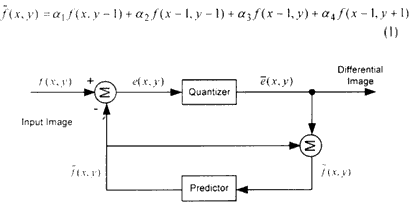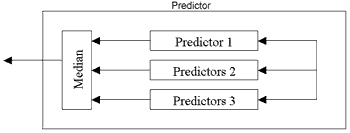| GISdevelopment.net ---> AARS ---> ACRS 1999 ---> Poster Session 5 |
Multispectral Image
Compression using Median Predictive Coding and Wavelet Transform
Chairat Rittirong,
Yuttapong Rangsanseri, and Punya Thitimajshima
Department of Telecommunications Engineering, Faculty of Engineering
King Mongkut's Institute of Technology Ladkraband, Bangkok 10520
Tel: (66-2)326-9967, Fax: (66-2)326-9086
Email: chairatr@scb.co.th , kryuttha@kmitl.ach.th , ktpunya@kmitl.ach.th
THAILAND
Keywords:
Image Compression, Difference Pulse Code Modulation, Wavelet
TransformDepartment of Telecommunications Engineering, Faculty of Engineering
King Mongkut's Institute of Technology Ladkraband, Bangkok 10520
Tel: (66-2)326-9967, Fax: (66-2)326-9086
Email: chairatr@scb.co.th , kryuttha@kmitl.ach.th , ktpunya@kmitl.ach.th
THAILAND
Abstract: This paper present a hybrid difference pulse code modulation (DPCM) and wavelet transform (WT) approach to lossy compression of multispectral remotely sensed images. First, the Karhunen-Loeve Transform removes the interband correlation to produce the principal components of the multispectral images. Each component is decomposed into 16 subbands by the wavelet transform using the uniform subband decomposition. Then, the lowest-fequency subband is coded with the lossless DPCM, and all other subbands coded is designed for each subband. The experimental results showed that the proposed method provides low bit-rate and high quality of the reconstructed image.
1.Introduction
Nowadys, the important research fields for multispectral remotely sensed images are image viewing, image analyzing over many spectral bands, image classification and image storing. All requires efficient method to reduce the redundant information. The fundamental of image compressionis to reduce the bit rate for transmission or storage while maintaining an acceptable image fidelityor image quality. The image compression must be save in the memory needed for image storage or in channel capacity required for image transmissin (Rabbani, 1991). The compression techniques must be able to reduce the number of bits required to represent the image by removing the image redundancy. There are many techniques to compress the image. The well-known compression techniques are wavelet transform and different pulse code mudulation (DPCK). However, a more efficient compression algorithm can be obtained by combining wavelet transform and DPCM together. Wavelet transforms using in copression techniques are described by (Antonini, 1992). And the DPCM, the prediction is subtracted from the actual pixel value to form a differential image. The differential image is then quantized and encoded. In this paper, we proposed an efficient technique based on median-predictor DPCM and wavelet transform.
2.Our Approach
Lossy compression of multispectral images is usually performed by applying the KLT which removes the interband correlation and produces the principal components of the by a lossy compression algorithm, which is a hybrid of median predictive coding and wavelet transform techniques. We describes the detail of these techniques in the following subsections.
2.1 Karhunen-Loeve Transform
The KLT is the optimal transform in an energy-packing sense; the KLT coefficients will contain a larger fractinof total energy as compared to any other transform. Unfortunately, the KLT basis functions are image-dependent and require and estimation of the image covariance function for their computation. Usually in remotely sensed multispectral images, there is a large amount of interband correlation due to the co-located sensors and the spectral overlap of the bands. The most effective technique to exploit this correlation is the application of the KLT that produces the principal components of the image.
2.2 Wavelet Transform
A two-dimensional wavelet transform can be implemented as a multi-level transformation. At the first level, the rows of the image being processed are low-pass (L) and high pass (H) filtered and downsampled. Next each column of the row filtered image are again low-pass and high-pass filtered and downsampled. The output of each level is then four subband images including: approximation coefficients (CA), horizontal detail coefficients (CH), vertical detail coefficinents (CV), and diagonal detail coefficients (CD). With uniform subband decompositon, the same process is repreated on every subband to form the next level of the structure. As a result, each of the four subband images is a quarter of the size of its initial image. For J-level decompositions, the image is thus decomposed into 4j subbands (Vetterli, 1995).
Several methods are presented in literature for wavelet-based image compression. A classical technique is based on uniform quantization of wavelet coefficients.
2.3 Median Predictive Coding
In predictive coding, the correlation of the neighboring pixel values is used to form a prediction for each pixel. The most common approach of predictive coding is DPCM (Veldhuis, 1993). In DPCM, the prediction is subtracted from actual pixel value to form a differential image that is much less correlated than the original image data, as shown in Figure 1. The pixel value is usually predicted with linear combination of its thee nearest pixels value such as :

Figure 1: DPCM encoding
The median predictors can also be used inDPCM (Salo, 1988). The prediction was chosen as the median value of three different predictions, i.e. the predictions are ranked in order of increasing value, and the middle value, and the middle value is chosen, as illustrated by Figure 2. In this study, the predictor is defined as:
predictor 1 (x,y) = pixel (x,y-1) (2)
predictor 2 (x,y) = pixel (x,1-y) (3)
predictors 3 (x,y) = 0.75 pixel (x,y-1) + 0.75 pixel (x-1,y)-(0.50pixel (x-1,y-1)) (4)
medianpredictors (x;y) = median (predictor1, predictors2,predictors3) (5)

Figure 2: Medium predictor.
2.4 Hybrid Median Predictive Coding and Wavelet Transform
The hybrid technique used in study is by applying median-predictor DPCM (MDPCM) to wavelet coefficients. Particular attention has to be paid to the lowest-frequency subband as introduced error could propagate in the reconstruction phase, resulting in a worse image quality. Therefore, the lossless MDPCM is applied to this subband, while the lossy MDPCM is used to code all remaining subbands, as illustrated in Figure 3 which is the case of 2-level wavelet decomposition. In lossy MDPCM, the differential image is subject to a quantization process, which determines the resulting bit rate and image quality. The Lloyd-Max quantizer (Gonzalex, 1992) was used in this study.

Figure 3: Application of median-predictor DPCM to wavelet coefficients
3. Experimental Results
A JERS-1/OPS image, size of 256 x 256 pixel, was used in this experiment. Figure 4 shows the first principal component image of KLT to be compressed. The reconstructed images resulted by the wavelet transform method and the proposed method, when the wavelet coefficients were quantized to 2,4 and 8 levels, are shown in Figure 5. The quality of the reconstructed images is measured in terms of MSE and PSNER, and the results are given in Table 1. We can see that the proposed method is superior to the classical wavelet-based method.

Figure 4: first principal component image.
| Quantization Level | MSE | PSNR | ||
| Wavelet | MDPCM-WT | Wavelet | MDPCM-WT | |
| 2 levels | 1095.2 | 80.7 | 65.9 | 77.2 |
| 4 levels | 401.2 | 34.3 | 70.2 | 80.9 |
| 8 levels | 140.2 | 32.2 | 74.8 | 81.2 |
| 256 levels | 1.3 | 0.0 | 95.3 | 358.4 |
4. Conclusion
A lossy compression algorithm for multispectral remote-sensing was described. We have shown that applying median-predictor DPCM on wavelet coefficients can improve the image quality when compared to the classical wavelet-based method at the same bit rate.

Figure 5: Reconstructed images resulted by the classical wavelet transform method (a,c,e) and by the proposed method (b,d,f) at various quantization levels. (a-b) 8-levels, (c-d) 4-levels, and (e-f) 2-levels.
Acknowledgement
The authors wish to thank the National Research council of Thailand (NRCT) for providing the satellite image data.
References
- Antonini, M., Barlaud, M., Mathieu P., and Daubechies, I., 1992. Image coding using wavelet transform. IEEE Transaction on Image Processing, 1(2), pp. 205-220.
- Gonzalez, R.C. and Woods, R.E., 1992. Digital Image Processing. Addison - Wesley Publishing Company, Inc.
- Rabbani, M. and Jones, P.W., 1991. Digital Image Compression Techniques. SPIE Optical Engineering Press, Bellingham, Washington USA.
- Salo, J., et al., 1988. Improving TV picture quality with linear-median type operations. IEEE Transction on Consumer Electronics, 34(3), pp. 375-379.
- Veldhuis, R. and Breeuwer, M., 1993. An Introduction to Source coding. Prentice Hall International (UK) Ltd.
- Vetterli, M. and Kovacevic, J., 1995. Wavelets and subband coding. Prentice Hall PTR, Englewood Cliffs, New Jersey, USA.